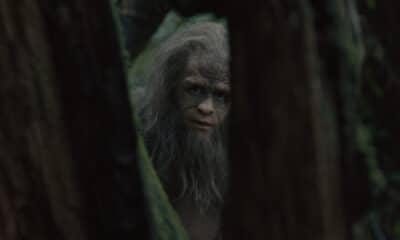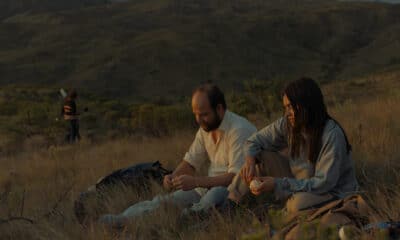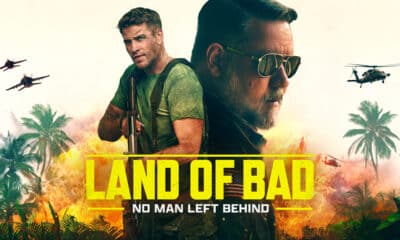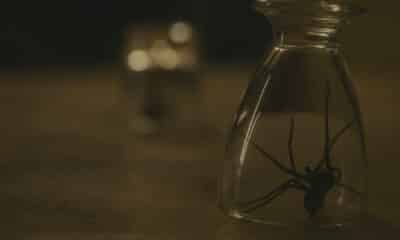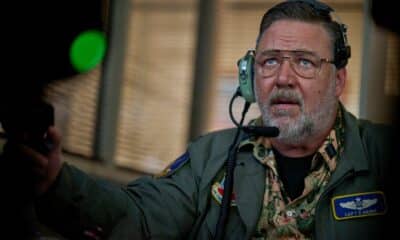2018 seems to be the horror year of the nun. This week Corin Hardy’s The Nun, the latest film in the The Conjuring universe, arrives in cinemas, but Hardy isn’t the only filmmaker to be drawn to the habit-wearing sisters. This year’s Arrow Video Frightfest featured a trio of nun-centric stories, one being The Devil’s Doorway.
Written and directed by Aislinn Clarke, The Devil’s Doorway tells a very different found-footage story. Set in the sixties and shot on film, this is a movie that feels very authentic to the time period it is trying to emulate. Not bad, especially when you factor in that this is Clarke’s first feature-length movie. Ahead of its screening, we caught-up with her to find out more about this very interesting entry into Frightfest’s New Blood line-up.

Aislinn Clarke Interview For The Devil’s Doorway
The Devil’s Doorway is your first feature film, as it’s a tale of horror, would it be right to assume that you’re a fan of the genre?
Oh God yeah, I’m a big horror fan. Always have been my whole entire life. It’s just a genre I’ve always gravitated towards. My dad was a big horror fan, he unfortunately died a couple of years ago, but he was a massive horror fan. Our Friday nights all through the eighties were all about getting a video out and seeing the new scary film.
Do you have any particular favourites?
I really love Rosemary’s Baby. I think it’s near perfect in so many ways. I love Don’t Look Now and probably a load more I can’t think of right now. In recent years, everybody is talking about the revival, there’s loads of great new horror films that have come out. Hereditary, that I saw recently, I thought was brilliant. I also liked The Babadook, It Follows, Starry Eyes. I have wide ranging tastes within the genre.

Aislinn Clarke Interview For The Devil’s Doorway
There were many ways that you could have told the story, what made you want to tell The Devil’s Doorway in a documentary / found-footage style?
Well that’s an interesting question because it didn’t happen how people think it did. I’ll tell you the short version of the genesis of this whole thing. So the producer Mark Huffam, who was the main producer, he came to me with a one page idea. He wanted to make a found-footage film, mostly for budgetary reasons, he wanted to do a found-footage film set in an abandoned Magdalene Laundry. But it would be contemporary and he wanted to shoot it on Go-Pro.
I think he went through several directors, I wasn’t the only one he came to. I thought it was really interesting to set a horror story in a Magdalene Laundry because there’s a lot of real-life trauma and horror there to unpack and use horror as a metaphor to explore. But I wouldn’t do it like this. I think you have to handle it very delicately to not be exploitative. That was my main concern. I didn’t want to make a film that was going to be exploitative. From day one that was my attitude towards the film. Of course I wanted to make feature film, he had a lot of finance already in place, the film was probably going to happen, he just needed a director. But I couldn’t do it unless it was going to be a film I could stand behind.
I came back to him and said I couldn’t do it like that, I didn’t think that would work for me, but I said, ‘why don’t we do it like this, found-footage is so overdone. There’s a lot of it out there. Some of it is really good and a lot of it is terrible. The audience don’t know yet if ours is going to be any good, so we have to do something to stand out. No-one really does period found footage…’ I had shot a lot on film, and it had been natural to both aesthetically to make it stand out within the sub-genre, but also to really get at the heart of the real humanness. The drama, the real human horror in these places, which for me, all good has to have at its core something truthful about it. The natural thing to do was to set it at the high point of these places when they were in full operation in 1960 and then shoot it on 16 mm, which is what the priests would have shot it on. That would set it apart from what we expect aesthetically from a found-footage film. He wanted to do a found-footage film, and had funding for a found-footage film, so I had to deliver a found-footage film, but I wanted to do it in a different way.

Aislinn Clarke Interview For The Devil’s Doorway
It’s set in the 60’s and I felt that the feel of the film, the way it was shot etc. all felt very authentic. What, if any, were the challenges of working in this way, I’m guessing maybe the price of film stock might have been an issue?
Well that was one of the hurdles that we had to get over. I thought I’d never hear from this guy again because he was talking to other directors. I just thought someone else will just do the Go-Pro found-footage contemporary film. What I was suggesting was so different to what he was talking about, I thought I might never hear from him again. But he was interested in it. Then we had to sell people on the idea of shooting on film.
They just thought we could use filters and so on. We shot some test footage to show them the difference between formats and they could see it. I’ve shot on film a lot, since I went to film school some fifteen years ago, and my DP has shot on film quite a bit. Together we have shot on 35 mm, I’ve done loads of 8 mm, this was our first 16 mm together, but for me the difference is stark. I think there’s trouble with digital filters that are supposed to emulate film and that it is that they are repetitive. Whereas the flaws in natural film are organic and they’re not repeated. I think on some level your eye notices that. If there’s a hair in certain parts, or a little bit of grain which shows-up in exactly the same place later, I think it just feels artificial. I’m certain that things like skin tones are near impossible to replicate digitally in my opinion. You just can’t get that richness of tone in digital that you can in film. So we had to prove that to them. Given that it was really important that it did feel like a real document, that we did stay away from any sense of artificiality as much as possible. We were able to convince them that first of all, it looked far better, it looked more authentic, and second of all that we had worked with film enough that we knew how to shoot economically on film.
Ryan my DP has good connections, he was able to source camera hire pretty cheap, and also stock. We only had fifteen days scheduled to shoot, so we had to be economical anyway, no matter what we were shooting on. We didn’t have the luxury of time to do a lot of takes, or to spend time trying to find the moment on set or anything like that. We had to be quite economical and quick so regardless of how we shot it that was the case. We weren’t gonna be wasting yards and yards of film because we couldn’t afford the time. Eventually, they agreed and I think it paid off. I think pretty much everybody agrees it was worth it.
That was the main challenge, in actually getting us to do it. I think almost everything that I’ve shot, I’ve shot on film. For me it didn’t feel as much of a challenge as it might be for someone who was shooting on film for the first time. I was used to thinking in that way. I was used to being conservative with my film. Not wasting it and having to think ahead. I don’t shoot and then think, I need to know what I’m doing before I go on set. That’s natural to me. I’ve worked a lot in theatre so I also have the habit of wanting to rehearse with actors before we go near the set. So that we know exactly what we’re doing, so we’re not wasting time and we’re not wasting film trying to work out certain things. Even blocking and things I work out in advance. Actors are generally very amenable to doing that. They love to do that. I’ve yet to meet an actor that doesn’t want to do that. They want to do as much work as possible so that they feel comfortable and that they can properly inhabit that character. I think that pays off too, and it helps you go on set and just shoot and not waste a lot of time or footage shooting around what you actually need to get at. The biggest hurdle was convincing the producers the rest of it was just second nature in the way that I was largely used to shooting.
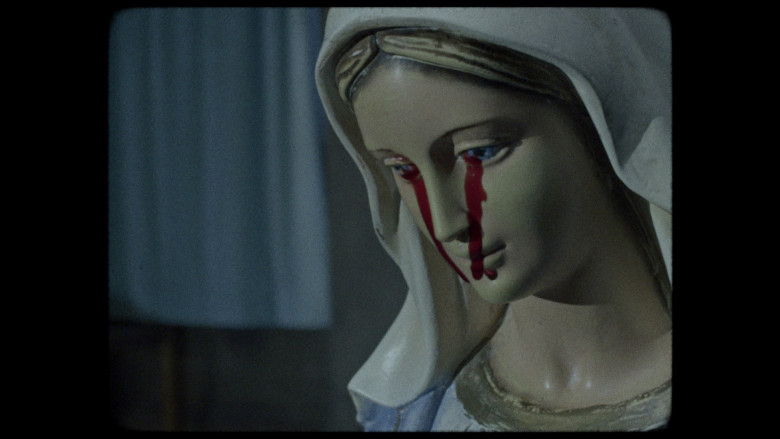
Aislinn Clarke Interview For The Devil’s Doorway
In terms of horror films, 2018 seems to be the year of the nun. Corin Hardy’s The Nun is out soon, and Frightfest itself has a couple of other nun-centric films Heretiks & St. Agatha on the rosta. Why do you think that they’re suddenly becoming prominent figures in this genre?
I don’t know, it is weird actually. I had no idea. I had seen the character of The Nun in the other Conjuring films where she’s a minor character, but I didn’t know that they were doing that film when we were shooting our film. I didn’t know about St. Agatha or Heretiks either. I think I only learned about them through Stiges or Frightfest, which we’re also in. I just don’t know, maybe there’s just something in the water.
As an Irish person, nuns are an ever present element of our educational lives and so on growing-up. It doesn’t seem like that much of a curiosity for an Irish person to have a story centred around nuns, and in particular Magdalene Laundries. They were something I was very aware of from childhood. My mother had a close friend who was literally dragged off the streets into the back of a priest’s car and taken to one of those places, in… I think the mid-sixties. That’s a story I remember hearing as a child, and that really stuck with me. Long before I saw the Magdalene Sisters, I knew about Magdalene Laundries. My father was a bread delivery man, he worked for a bakery and delivered to all the convents, and I remember him saying he hated going to the Magdalene Laundry in the town he grew-up. He just thought it was like Hell. He felt so sorry for the women in there. I’ve always been aware of them.
I think it’s largely coincidental that these films are coming out this year in particular. I don’t know, I guess it’s just one of those moments. For me, I’ve always been interested in telling a story like this. Something in the Holy Water I guess.

Aislinn Clarke Interview For The Devil’s Doorway
The Devil’s Doorway screens at Frightfest, what are you hoping the audience experience will be?
Well generally speaking I always hope the audience are going to like it. At the same time I know that that is completely beyond my control. I just say that I make the film for the people who like it. There are people that don’t like it, and that’s fine. I’m glad when there are people that do like it, and they are the people I made it for. I think you could freak yourself out by thinking too much about an audience before you go into a screening.
So far at screenings, there’s been a really good response. It’s been really positive and I’ve had really interesting questions at the end, and the audience have been very engaged. I was at the first couple of public showings in New York when IFC did their theatrical release in July, just to do Q&As and stuff. I was really amazed that this is a normal Friday night and people are going to the cinema, it’s not a festival or anything like that. But every single person that came to the film stayed on until afterwards, and all through the credits for the Q&A. I thought that was really amazing.
What’s next now that The Devil’s Doorway is in the world?
I have a couple of different… I’m always spinning a load of plates, like freelancers do – I’ve got several different projects that I’m attached to as a director, or that I’ve written. They’re at very different stages. Then with financing, it’s always like a house of cards, you don’t know whose going to get all of the pieces in place first. I have a project that I’m really excited about with Fantastic Films who did The Hallow and Wake Wood. That’s a project that I’ve written and would be directing with them. It’s looking good at this minute. Then I have a TV show, a pilot that I’ve written, which is with another company. So I think one or the other of them, fingers crossed, I’ll be shooting in 2019.
The Devil’s Doorway screened at Arrow Video Frightfest 2018, give our review a read here.
Kat Hughes is a UK born film critic and interviewer who has a passion for horror films. An editor for THN, Kat is also a Rotten Tomatoes Approved Critic. She has bylines with Ghouls Magazine, Arrow Video, Film Stories, Certified Forgotten and FILMHOUNDS and has had essays published in home entertainment releases by Vinegar Syndrome and Second Sight. When not writing about horror, Kat hosts micro podcast Movies with Mummy along with her five-year-old daughter.

Latest Posts
-


Apple TV
/ 5 hours agoTrailer: André Holland leads Apple’s new limited series, ‘The Big Cigar’
Apple TV+ has released the full trailer for The Big Cigar, a new, six-episode...
By Paul Heath -


Film News
/ 6 hours agoUK trailer, poster and release date for Sundance smash ‘Sasquatch Sunset’
Premiering in the UK at the Sundance London event in June is the brilliant...
By Paul Heath -


Disney+
/ 8 hours agoNew trailer for ‘Becoming Karl Lagerfeld’ with Daniel Brühl
A trailer has landed for the June-released Becoming Karl Lagerfeld, the Disney+/ Hulu series...
By Paul Heath -


Film News
/ 8 hours agoUK release date revealed for Cannes film ‘The Delinquents’
MUBI has announced the release date for The Delinquents, the Cannes Un Certain Regard-premiering...
By Paul Heath


